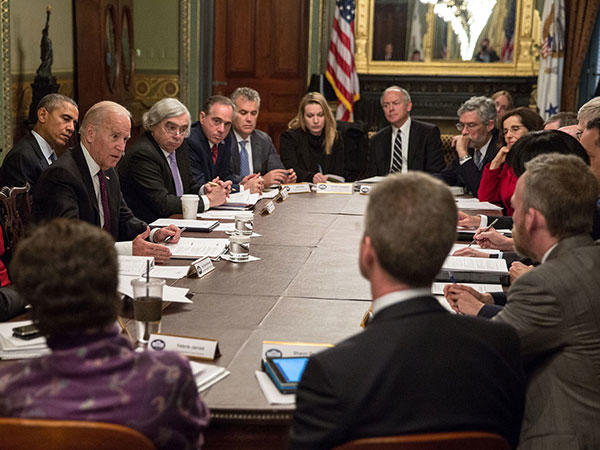History of the Cancer Moonshot℠
During his State of the Union address on January 12, 2016, President Barack Obama announced the establishment of a Cancer Moonshot to accelerate cancer research. The effort, initially funded through the 21st Century Cures Act passed in 2016, had the ambitious goal of making a decade's worth of progress in cancer prevention, diagnosis, and treatment in just 5 years.
White House Cancer Moonshot Task Force
President Obama appointed then Vice President Joe Biden to chair the White House Cancer Moonshot Task Force charged with producing a detailed set of findings and recommendations to:
- accelerate our understanding of cancer and its prevention, early detection, treatment, and cure
- improve patient access and care
- support greater access to new research, data, and computational capabilities
- encourage development of cancer treatments
- identify and address any unnecessary regulatory barriers and consider ways to expedite administrative reforms
- ensure optimal investment of federal resources
- identify opportunities to develop public–private partnerships and increase coordination of the federal government’s efforts with the private sector, as appropriate
To ensure that the Cancer Moonshot's goals and approaches are grounded in the best science, President Obama directed the Cancer Moonshot Task Force to consult with external experts, including the presidentially appointed National Cancer Advisory Board (NCAB). A Blue Ribbon Panel of experts was established as a working group of the NCAB to assist the board in providing this advice.
Blue Ribbon Panel
At the Blue Ribbon Panel's (BRP) first (virtual) meeting on April 11, 2016, panel members agreed to establish seven working groups to focus on major topic areas. The working groups began with broad discussions of the state of the field for their respective topics and considered more than 1,600 ideas submitted by the members and the broader cancer community at large. (Read the report about the public idea submission site.)
The BRP presented the working groups' recommendations in a final report to the NCAB in September 2016. Download the complete report.
The BRP report describes 10 transformative research recommendations for achieving the Cancer Moonshot's goal of making a decade's worth of progress in cancer prevention, diagnosis, and treatment in just 5 years.
- establish a network for direct patient involvement
Engage patients to contribute their comprehensive tumor profile data to expand knowledge about what therapies work, in whom, and in which types of cancer. - create a translational science network devoted exclusively to immunotherapy
Establish a cancer immunotherapy network to discover why immunotherapy is effective in some patients but not in others. - develop ways to overcome cancer’s resistance to therapy
Identify therapeutic targets to overcome drug resistance through studies that determine the mechanisms that lead cancer cells to become resistant to previously effective treatments. - build a National Cancer Data Ecosystem
Create a national ecosystem for sharing and analyzing cancer data so that researchers, clinicians, and patients will be able to contribute data, which will facilitate efficient data analysis. - intensify research on the major drivers of childhood cancers
Improve our understanding of fusion oncoproteins in pediatric cancer and use new preclinical models to develop inhibitors that target them. - minimize cancer treatment’s debilitating side effects
Accelerate the development of guidelines for routine monitoring and management of patient-reported symptoms to minimize debilitating side effects of cancer and its treatment. - expand use of proven cancer prevention and early detection strategies
Reduce cancer risk and cancer health disparities through approaches in development, testing, and broad adoption of proven prevention strategies. - mine past patient data to predict future patient outcomes
Predict response to standard treatments through retrospective analysis of patient specimens. - develop a 3-D cancer atlas
Create dynamic 3-D maps of human tumor evolution to document the genetic lesions and cellular interactions of each tumor as it evolves from a precancerous lesion to advanced cancer. - develop new cancer technologies
Develop new enabling cancer technologies to characterize tumors and test therapies.
NCI established implementation teams that align with each of the BRP recommendations. The teams identified opportunities and developed initiatives for funding that address each of the recommendations.
Cancer Cabinet
In February 2022, President Biden kickstarted the next phase of the Cancer Moonshot with bold new goals: to reduce the cancer death rate by half within 25 years and improve the lives of people with cancer and cancer survivors.
The following month, the White House convened the Cancer Cabinet, bringing together departments and agencies from across the federal government to establish a prioritized agenda across government, including the development of new interagency programs and collaborations. The Cancer Cabinet includes members from the following executive branch departments, agencies, and offices:
- Department of Health and Human Services
- Department of Veterans Affairs
- Department of Defense
- Department of Energy
- Department of Agriculture
- Environmental Protection Agency
- National Institutes of Health
- National Cancer Institute
- Food and Drug Administration
- Centers for Medicare & Medicaid Services
- Centers for Disease Control and Prevention
- Office of Science and Technology Policy
- Domestic Policy Council
- Gender Policy Council
- Office of the First Lady
- Office of the Vice President
- Office of Management and Budget
- Office of Legislative Affairs
- Office of Public Engagement
- additional members, as needed, to help establish and make progress on Cancer Moonshot goals

